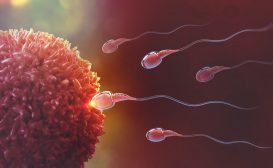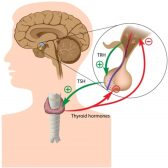Definition
noun, plural: progesterones
A progestogen hormone, with a chemical formula of C21H30O2, naturally produced in both males and females but is more predominant in quantity in females whereby it functions primarily in pregnancy maintenance
Supplement
Progesterone is a major progestogen hormone. It has a chemical formula of C21H30O2. It is naturally occurring produced in the corpus luteum. It has a double bond between carbon-4 and carbon-5. It has two ketone groups: one at carbon-3 and the other at carbon-20.
In females, progesterone occurs during menstrual cycle, estrous, pregnancy, and embryogenesis. It is sometimes referred to as the pregnancy hormone because of its role during pregnancy. Progesterone prepares the uterus for pregnancy and the implantation of the blastocyst. It promotes the proliferation of uterine mucosa. It also acts as an antagonist of estrogens and prevents further follicular development. It inhibits lactation prior to parturition.
In females, progesterone is biosynthesized chiefly in the corpus luteum of the ovaries (and then in the placenta beginning at the luteal-placental shift in pregnancy). In males, progesterone is biosynthesized in the testes and in the adrenal glands. A small percentage of progesterone synthesis occurs in the adrenal glands. Still, to a lesser extent, it is produced in the brain and the adipose tissues. The presence of luteinizing hormone stimulates the production of progesterone. Through steroidogenesis, progesterone is produced from pregnenolone, which, in turn, is derived from cholesterol. Progesterones released into the circulation are bound to albumin and transcortin.
In males, progesterone is crucial as well since it serves as a precursor to the major male sex hormone, testosterone. In humans, the level of testosterone declines while the level of estrogen rises as men age. This condition may lead to decreased libido, weight gain, depression, hair loss, gynecomastia, impotence, bone loss, and muscle loss.
Progesterone also serves as a neurosteroid and a metabolite in the biosynthesis of other endogenous steroids.
Progesterone is also produced synthetically for use as a medication for gynecological disorders.
IUPAC name:
- (8S,9S,10R,13S,14S,17S)-17-acetyl-10,13-dimethyl-1,2,6,7,8,9,11,12,14,15,16,17-dodecahydrocyclopentaaphenanthren-3-one
Chemical formula:
Abbreviation:
- P4
Synonym(s):
See also:
- progestogen
- Luteal phase
- Contraceptives
- Luteinizing hormone
- Steroidogenesis
Related terms:




